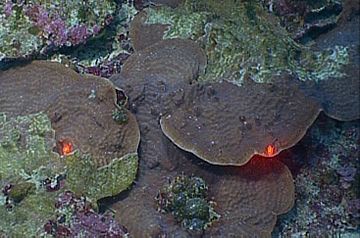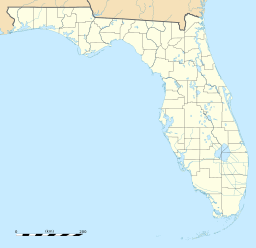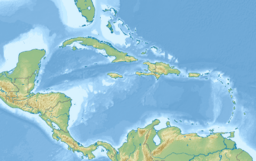Pulley Ridge facts for kids
Quick facts for kids Pulley Ridge |
|
|---|---|

Projoverview coral figure 2 750
|
|
| Location | |
| Location | Caribbean |
| Coordinates | 24°45′00″N 83°45′00″W / 24.75000°N 83.75000°W |
| Country | United States |
| Geology | |
| Type | reef |
Pulley Ridge is a special kind of coral reef system. It's located off the coast of the United States. This reef is unique because it's a "mesophotic" reef. This means it's a deep-water reef that still gets some sunlight.
Pulley Ridge sits on old, sunken islands. It's about 100 miles west of the Tortugas Ecological Reserve. The reef stretches north for about 60 miles. Its depths range from 60 to 80 meters (about 200 to 260 feet).
Fishermen knew about Pulley Ridge for a long time. But scientists didn't discover it until 1999. This happened during a trip by the U.S. Geological Survey (USGS). Students from the University of South Florida were also there.
Like other deep-water reefs, Pulley Ridge has special corals. These corals and algae can make their own food using sunlight. They are adapted to living in low-light conditions. Many types of fish live here, too. This includes red grouper, which use the area to lay their eggs.
Robert Halley, a former USGS marine geologist, said something important. He noted that Pulley Ridge is the deepest reef known today. It's the deepest one where corals still use sunlight to grow. Other reefs are usually found about 46 meters (150 feet) below the sea.
Once corals grow on the seabed, they create a hard home. This home attracts many different plants and animals. Some species are only found in these deep reefs. Others also live in shallower reefs. Scientists want to know how these deep reefs are connected. They also want to know how species move between them. This information helps protect the reefs. Exploring these deep reefs is hard because they are so far down.
Coral reefs around the world are in trouble. In the last 10 years, 25% of known living coral reefs have been lost. Things like climate change, too much fishing, and pollution hurt them. Scientists hope that studying Pulley Ridge will help them understand reefs better. This knowledge can help save other reefs.
Exploring Pulley Ridge: The First Dives
In 2002, a group funded an expedition to Pulley Ridge. They wanted to study the habitat and the fish there. Bob Halley from the U.S. Geological Survey led this trip.
More trips followed this first exploration. One important trip was in 2005. James K. Culter from the Mote Marine Laboratory led it. Over 40 team members joined him. The trip lasted from June 23 to July 1, 2005.
The main goal was to collect information and samples. They also took many photos and videos of the marine life. The expedition explored depths from 200 to 260 feet. It's rare for scientists to explore this depth. It's deeper than regular scuba diving limits. It's also shallower than where deep-sea submersibles usually go.
During these dives, scientists made interesting discoveries. They found bacteria that glow in the dark, called bioluminescent bacteria. These might be important to the reef.
Culter noticed fewer fish on Pulley Ridge compared to shallow reefs. They saw Tilefish and groupers. He thought the fish might have been scared away by the divers. Or maybe the fish only come out at night. There were also fewer crabs and shrimp (called Crustacea) than expected. But many different types of algae were present.
Connecting Reefs: Pulley Ridge to the Florida Keys
In 2011, a big project started. It aimed to learn how Pulley Ridge connects to other reefs. This included reefs in the Gulf of Mexico and the Florida Keys. NOAA helped fund this important work.
Thirty-five scientists from 11 different places joined this project. They studied many things. This included tracking tiny ocean creatures called plankton. They also studied the seabed and how fish use the habitat.
A big part of the project was genetic studies. Scientists looked at the DNA of reef species. This helped them see how different groups of animals are connected. They also studied the structure of Pulley Ridge's deep-water communities. They even looked at how valuable Pulley Ridge is for the economy.
The results from this study are very important. They give resource managers key information. This helps them manage and protect both shallow and deep-water coral reefs.
The project logs describe many species they focused on. These ranged from deep-water algae to red grouper.



